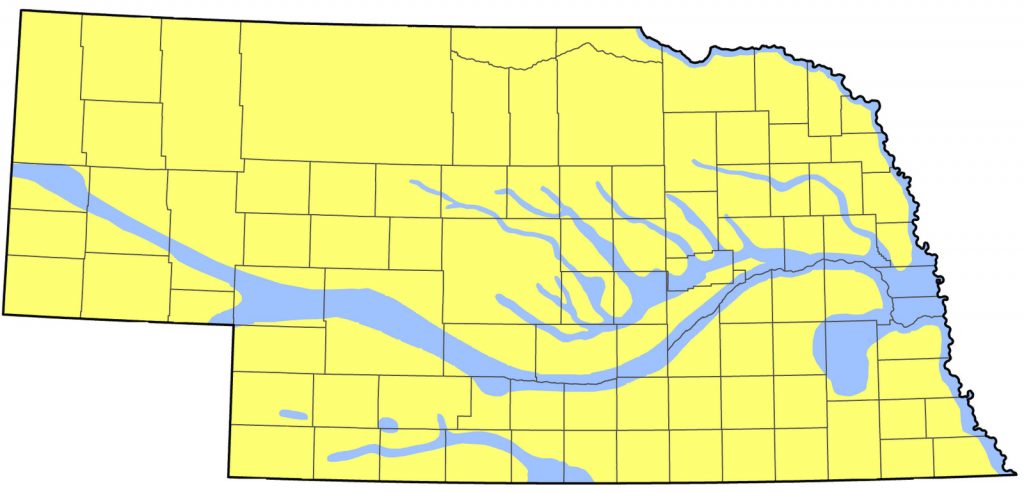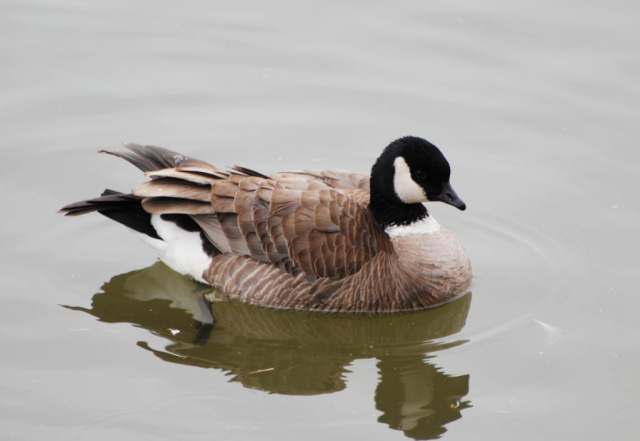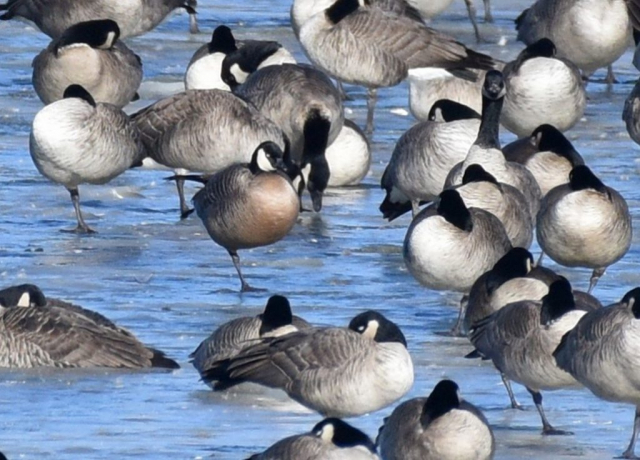Branta hutchinsii hutchinsii, B. H. MINIMA, B. H. TAVERNERI
Status: Common, locally abundant, regular spring and fall migrant statewide. Fairly common regular winter visitor west and central, uncommon east. Rare regular summer visitor central and east, rare casual west.

Documentation: hutchinsii: specimen, SUI 06721, 8 Nov 1884, Elm Creek, Buffalo Co; minima: photograph, Mlodinow eBird Checklist – 10 Jan 2022); taverneri: photograph, Mlodinow eBird Checklist – 20 Mar 2021).
Taxonomy: Of the 11-12 subspecies of Canada Goose recognized prior to 2004, genetic studies have shown that two clades can be differentiated, seven large subspecies in one and four small subspecies in the other (Banks et al 2004, AviList 2025). Banks et al (2004) designated each of these two groups as full species, the newly designated species Cackling Goose (B. hutchinsii) consisting of the four small subspecies hutchinsii, taverneri, minima, and leucopareia; the remaining seven large subspecies were retained in Canada Goose (B. canadensis). Pyle (2025) synonymized B. h. taverneri with B. canadensis parvipes (see below).
The only subspecies of Cackling Goose expected to occur regularly in Nebraska is hutchinsii (Silcock 2006, Mowbray et al 2020), sometimes known as “Hutch” or Richardson’s Goose. This taxon is a small pale-breasted Arctic goose which migrates through central and eastern Nebraska, with high concentrations in the Rainwater Basin in spring. A specimen of “Cackling Goose” taken in spring 1911 near Trumbull, Clay Co was listed as HMM 2381 (Brooking, Notes), and a “Cackling Goose” was collected 20 Mar 1905 at Kearney by C.A. Black (Swenk, Notes After 1925).
Occurrence of minima in Nebraska was not documented until singles were photographed near Scottsbluff, Scotts Bluff Co among B. h. hutchinsii Cackling Geese 10 Jan 2022 (Mlodinow, eBird.org) and 1 Dec 2022 in Scotts Bluff Co (Mlodinow, eBird.org). Previously, there had been three equivocal reports, none with photographs, as follows: a group of 12 birds identified as minima was in Sarpy Co 28 Feb 2004, four Cackling Geese near North Platte 6 Feb 2013 had “dark breasts with purplish sheen” (T.J. Walker, personal communication), and a very dark bird with a prominent white neck ring was at Grandpa’s Steakhouse Pond, Kearney Co 7 Mar 2015. The latter two reports are indeed suggestive of minima, although Abraham (2005) stated that small, dark-breasted geese in the eastern United States are either dark hutchinsii or escapes. According to eBird (eBird.org, accessed April 2023), there are about 12 scattered reports east of the Great Plains; the Nebraska records are the only ones shown for the Great Plains. However, there are about 8-10 records, all of single birds, six in the period 17 Dec-7 Mar, and 2-4 around Chatfield Reservoir Mar-Sep 1999 and 5 May 2000 that are likely of one non-migratory individual (eBird.org, accessed Apr 2023).
The taxon taverneri had been reported in Nebraska (Rapp et al 1958), although until recently there was no tangible evidence supporting its occurrence. There are now five records for Nebraska, most with photographs supportive of taverneri: a flock of 80 Cackling Geese in Scotts Bluff Co 20 Mar 2021 exhibited some variability but the overall impression and photographs matched birds identified as taverneri on the West Coast (Mlodinow, eBird.org).; a single was photographed at Kissinger Basin WMA, Clay Co 30 Jun 2021 (Strand, eBird.org); four were at Bridgeport, Morrill Co 7 Mar 2022 (Mlodinow, eBird.org); five were in Chase Co 18 Mar 2022 (Mlodinow, eBird.org); and one was in Scotts Bluff Co 4 Dec 2022 (Brenner, DaRugna, eBird.org). There are about eight records of taverneri on the Great Plains in eastern Colorado, western Kansas, and far western Oklahoma (eBird.org, accessed April 2023).
Although it is generally thought that Cackling Geese breeding on the North Slope of northeast Alaska and northwest Canada are taverneri (for example, Baldassarre 2014), intergrades between taverneri and hutchinsii are also likely to be present in this area, which appears to be an overlap zone between these two taxa (Steven Mlodinow, personal communication, Abraham 2005). However, Mlodinow et al (2024) note that “Taverner’s Cackling Goose and minima Cackling Goose favor different habitats in the Yukon-Kuskokwim Delta and there is no obvious phenotypic cline between these parapatric populations”. If indeed taverneri and hutchinsii are parapatric, uncertainty regarding the relationships of taverneri become an open question. An intriguing treatment is that of Pyle (2025), who synonymized B. h. taverneri with B. c. parvipes due to the generally accepted 75% rule for subspecies diagnosability not being met between these two taxa. Interestingly, all recoveries of molting white-cheeked geese banded in these areas of Arctic tundra have come from east of the Rockies (C. Ely, cited by Mlodinow, 2008). As noted by Mlodinow (2008), “it seems unlikely that none were the local breeders”, and thus an unknown number of taverneri or taverneri intergrades may winter on the Great Plains, including Nebraska. Clearly, identification of such birds presents a major challenge in Nebraska, given the large numbers of hutchinsii and especially B. canadensis parvipes present.
In the 2017 eBird Taxonomy Update, “studies show that size of Canada Geese is driven largely by nutrition as juveniles, raising a legitimate question about whether variation in size is more a result of genetics or nutrition, with birds possibly averaging smaller in the West. Some suggest that parvipes may not be a valid subspecies … safely separable from canadensis/interior, so we merge it with the latter group”. However, see discussion above re taverneri and parvipes.
Further complicating matters are questions about the relevance of the Type of taverneri to current Cackling Goose taxonomy, as suggested by Jaramillo (post to “Advanced Bird ID” Facebook group, Jan 2022). An interesting observation that “a disturbingly high proportion of Cackling Geese during summer in Colorado look more like [Taverner’s than Richardson’s]” suggests that identification of taverneri-like Cackling Geese, especially single or out-of-season individuals requires care and good photographs, and even then may not be possible (Steven Mlodinow, personal communication). Examples are here and here.
Hybrids of Cackling Goose and other species have been reported in Nebraska; see Snow Goose x Cackling Goose, Ross’s Goose x Cackling Goose, Greater White-fronted Goose x Cackling Goose, and Barnacle Goose x Cackling Goose.
Spring: There are several winter and summer records that make it difficult to determine spring arrival and departure dates, but, as with other goose species, migrants are usually in flocks of at least 5-10 individuals, rather than the singles or small (family?) groups that occur in winter and summer, and may appear as early as late Jan. Large concentrations build in late Feb, particularly in western and south-central Nebraska, declining again by mid-Apr. Timing and duration of peak numbers is variable and usually occurs during mid-March and is likely influenced by weather.
- High counts: 32,800 at three locations in Scotts Bluff Co 22 Mar 2022, 9000 at two locations in Scotts Bluff Co11 Mar 2023, and 5500 in Hamilton Co 15 Mar 2022.
Summer: Movement is minimal between early May and late Sep; sightings between these dates are generally of injured singles, including long-staying individuals at Clay Co Wetland #32 May-Jul 2004, one in Cedar Co 22 Apr-26 Aug 2019, and one that remained at Schramm SP, Sarpy Co from 17 Sep 2005 through at least 8 Sep 2007. Reports Jul-Sep 2024 were of 1-2 at a surprising six locations, and, in 2025, at five locations Jun-Jul.
The only Panhandle records for Jun-Jul are of singles at Gering WTP, Scotts Bluff Co 1-13 Jun 2022, Oliver Reservoir, Kimball Co 5 Jun 2020, and at Scottsbluff WTP, Scotts Bluff Co 8 Jul 2020, 23 Jun 2022, 27 Jul 2023, and 21 Jul 2025.
Fall: Migration begins in late Sep and reaches its peak in mid-Oct. Flocks may linger as late as early Jan depending upon weather and food availability. Nebraska CBCs held in mid- to late Dec often record significant numbers, such as the 2012-2013 overall total of 7683.
- High counts: 31,000 at Lake Minatare, Scotts Bluff Co 29 Nov 2021, 28,500 there 20 Nov 2020, and 20,000 there 14 Dec 2021 and 17 Nov 2023.
Winter: Most winter on the Gulf Coast and from western Texas into Mexico (Baldassare 2014). Large mid-winter (15 Jan-7 Feb) flocks can occur in Nebraska, however, if conditions allow, such as the 20,000 at Jeffrey Reservoir, Lincoln Co area 30 Jan 2010, 11,000 at Lake Minatare, Scotts Bluff Co 22 Jan 2021, and 4800 on a pond in south Scottsbluff, Scotts Bluff Co 20 Jan 2022. Less common in the east in mid-winter, 150 were at Pawnee SRA, Lancaster Co, 75 were at Standing Bear Lake, Douglas Co 26 Jan 2025, and 61 were near Lincoln, Lancaster Co 31 Jan 2022.
Images
Abbreviations
CBC: Christmas Bird Count
HMM: Hastings Municipal Museum
SP: State Park
SUI: University of Iowa Museum of Natural History
WMA: (State) Wildlife Management Area
WTP: (Federal) Waterfowl Production Area
Literature Cited
Abraham, K. 2005. Cackling Goose, NOT new to Ontario. Ontario Field Ornithologists 23: 2-6.
AviList Core Team, 2025. AviList: The Global Avian Checklist, v2025. https://doi.org/10.2173/avilist.v2025.
Baldassarre, G. 2014. Ducks, geese, and swans of North America. Johns Hopkins University Press, Baltimore, Maryland, USA.
Banks, R.C., C. Cicero, J.L. Dunn, A.W. Kratter, P.C. Rasmussen, J.V. Remsen, Jr., J.A. Rising, and D.F. Stotz. 2004. Forty-fifth supplement to the American Ornithologists’ Union check-list of North American birds. Auk 121: 985-995.
Brooking, A.M. Notes. Bird specimen records. Manuscript in Nebraska Ornithologists’ Union Archives, University of Nebraska State Museum, Lincoln, Nebraska, USA.
Mlodinow, S.G., P. Pyle, T.B. Mowbray, C.R. Ely, J.S. Sedinger, R.E. Trost, K.A. Spragens, and M.A. Patten. 2024. Cackling Goose (Branta hutchinsii), version 2.0. In Birds of the World (N. D. Sly, P. G. Rodewald, and B. K. Keeney, Editors). Cornell Lab of Ornithology, Ithaca, NY, USA. https://doi.org/10.2173/bow.cacgoo1.02.
Mlodinow, S.G, P.F. Springer, B. Deuel, L.S. Semo, T.L. Leukering, T.D. Schonewald, W. Tweit, and J. Barry. 2008. Distribution and Identification of Cackling Goose (Branta hutchinsii) Subspecies. North American Birds 62: 344-360.
Mowbray, T.B., C.R. Ely, J.S. Sedinger, and R.E. Trost. 2020. Cackling Goose (Branta hutchinsii), version 1.0. In Birds of the World (P. G. Rodewald and B. K. Keeney, Editors). Cornell Lab of Ornithology, Ithaca, NY, USA. https://doi.org/10.2173/bow.cacgoo1.01.
Pyle, P. 2025. A Practical Subspecies Taxonomy for North American Birds. North American Birds 76(1).
Rapp, W.F. Jr., J.L.C. Rapp, H.E. Baumgarten, and R.A. Moser. 1958. Revised checklist of Nebraska birds. Occasional Papers No. 5, Nebraska Ornithologists’ Union, Crete, Nebraska, USA.
Silcock, W.R. 2006. White-cheeked geese in Nebraska. NBR 74: 99-105.
Swenk, M.H. Notes after 1925. Critical notes on specimens in Brooking, Black, and Olson collections made subsequent to January 1, 1925. Handwritten manuscript in the Nebraska Ornithologists’ Union Archives, University of Nebraska State Museum, Lincoln, Nebraska, USA.
Recommended Citation
Silcock, W.R., and J.G. Jorgensen. 2025. Cackling Goose (Branta hutchinsii). In Birds of Nebraska — Online. www.BirdsofNebraska.org
Birds of Nebraska – Online
Updated 5 Sep 2025


